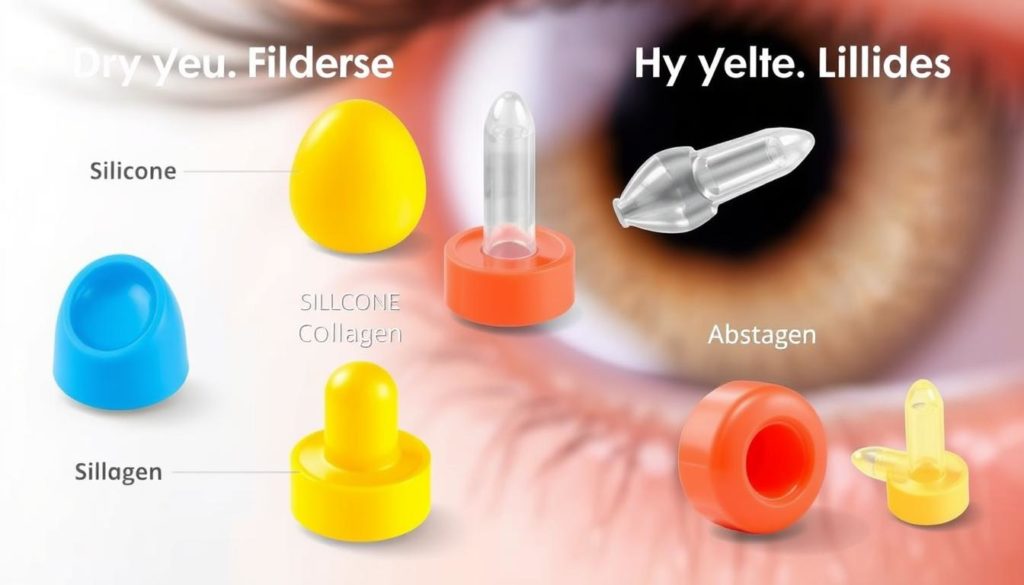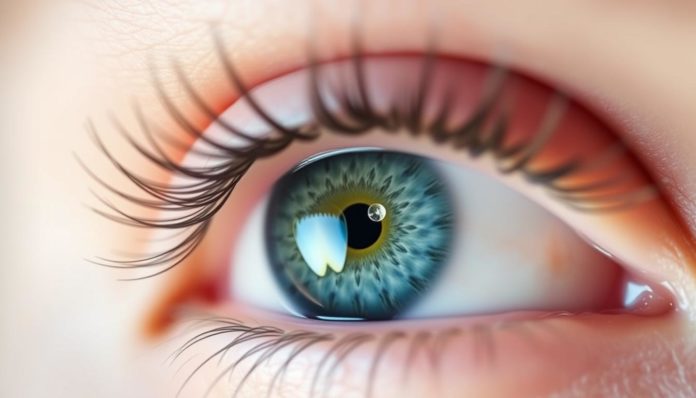Did you know that nearly 16 million Americans suffer from dry eye syndrome? Traditional treatments like artificial tears often don’t provide enough relief. That’s where punctal plugs come in as a promising solution for persistent dry eye relief.
Punctal plugs help by reducing tear drainage and keeping the eye’s surface moist. These tiny devices, also known as punctal occlusion treatments, can be a game-changer. They work well when other treatments don’t, offering the hydration boost your eyes need.
What are Punctal Plugs?
Punctal plugs, also called tear duct plugs, are tiny devices. They block the tear ducts to stop tears from draining away too fast. This helps keep eyes moist, reducing dry eyes, itchiness, and redness.

Definition of Punctal Plugs
Punctal plugs are as small as a grain of rice. They go into the puncta, the tiny openings in the corners of your eyelids. These openings lead to the tear drainage system.
They can be placed in both the upper and lower eyelids. This makes sure tears stay on your eyes longer, keeping them moist.
How They Work
Punctal plugs keep your eyes’ natural moisture by blocking tear ducts. This reduces tear drainage, which means your eyes stay lubricated. Sometimes, they are put into a deeper part of the tear duct, the canaliculus. This helps save even more tears.
Types of Punctal Plugs
Punctal plugs, also known as lacrimal plugs, help those with dry eye. There are different kinds, each offering relief in its own way. Knowing the differences helps choose the right one for you.

Temporary/Dissolving Plugs
Temporary punctal plugs are often made from collagen. They dissolve over time. These plugs are good for recovery after surgery like LASIK. They’re also great for testing punctal plugs without committing long-term.
Semi-permanent Plugs
For a more lasting option, consider semi-permanent plugs made of silicone or acrylic. These plugs stay in place for a long time but can be removed if needed. They offer a durable solution for those with chronic dry eye.
Intracanalicular Plugs
Intracanalicular plugs last the longest and go deeper into the tear duct. These plugs are not visible and remain secure. But, removing them might require a minor surgery. They are usually the best for severe dry eye problems.
How Punctal Plugs for Dry Eye Provide Relief
Punctal plugs are popular for dry eye relief. They work well by keeping the eye moist. They do this by blocking the tear drainage ducts.
Mechanism of Action
Punctal plugs treat dry eye by blocking the tear ducts. This keeps tears on the eye, making it moist. It helps those with poor tear production or quality.
They make the eyes more comfortable by keeping them wet.
Effectiveness Compared to Other Treatments
Punctal plugs are easier and more effective than some treatments. Unlike artificial tears, they offer lasting comfort. They make eye meds work better by keeping drops on the eye longer.
This helps the medicine work better. Punctal plugs are good when other treatments don’t work.
Procedure for Inserting Punctal Plugs
Getting punctal plugs put in is a quick and simple way to help with dry eye symptoms. It starts with an in-depth check-up by your eye doctor to make sure everything goes smoothly.
Initial Examination
The eye care expert will first figure out what you specifically need during the check-up. They decide on the right size and type of punctal plug for you. Your eye doctor might use some numbing drops to make sure you’re comfortable.
Insertion Process
The insertion of punctal plugs feels more like pressure than pain, and it doesn’t hurt much. A clean tool is used by the eye care professional to place the plug into your tear duct. This quick step lets you get back to your daily life soon after, without much waiting.
It’s important to see your doctor for follow-ups to check on your progress. This helps in avoiding any issues and makes sure the plugs are working right for you.
Benefits of Punctal Plugs
Punctal plugs help those who need relief from dry eye. These small items fit into the tear ducts. They keep the eye’s natural moisture, which is good for eye health. By keeping tears on the eye’s surface longer, they make the eye more comfortable. This reduces the need for artificial tears.
The use of punctal plugs brings several benefits:
- Dry eye relief without constant medication.
- Better eye health by keeping natural tear film.
- More comfort and a better life for people with moderate to severe dry eye.
- Possible better vision because of steady moisture.
- A cost-effective and durable option compared to daily eye drops.
Punctal plugs are also great for those who didn’t find other treatments helpful. They offer a solution that doesn’t involve drugs. This can be an important part of someone’s care for their eyes.
| Benefit | Description |
|---|---|
| Dry Eye Relief | Reduces the need for artificial tears by providing lasting moisture. |
| Eye Health | Keeps eyes healthy and well-lubricated by saving natural tears. |
| Comfort | Improves overall comfort by keeping a stable tear film. |
| Vision Improvement | Could make vision better with consistent lubrication. |
| Cost-effective | A more lasting solution than using eye drops every day. |
Risks and Side Effects of Punctal Plugs
Punctal plugs can greatly ease dry eye symptoms. But, they also have their own risks and side effects. Knowing these can help you choose wisely about using punctal occluders for your eyes.
Common Side Effects
Some people feel a scratchy sensation or may tear up more than usual. This could mean the punctal occluders aren’t fitting right. Others may have an allergic response to the plug’s materials.
Serious Risks
Sometimes, serious issues can arise. An ill-fitting or sticking out plug might really irritate the eye or eyelid. Inflammation in the tear ducts can occur, causing redness and swelling. In extreme cases, severe irritation may require surgically removing the plugs.
Rarely, an infection could develop necessitating antibiotics or plug removal. For more info on these risks, here’s a comprehensive guide.
How to Care for Your Punctal Plugs
Proper care for punctal plugs is crucial for good eye health. It ensures you get the full benefits of punctal occlusion. Follow these simple guidelines to keep your eyes comfortable and free from complications.
Routine Eye Care
When you have punctal plugs, regular eye care is vital. Here’s what you should do:
- Avoid rubbing your eyes hard to prevent losing the plugs.
- Always clean your hands before touching your eyes. This reduces the chance of infections.
- Use the eye drops your doctor gave you to keep your eyes moist and healthy.
- Regularly look for any signs of discomfort or strange discharge in your eyes.
When to Contact Your Doctor
Keep an eye on your condition and talk to your doctor if you notice any problems. Reach out to your doctor if you see:
- Constant discomfort or pain in your eyes.
- A lot of tears that don’t get better.
- Any signs of infection, like redness or odd discharge.
- A feeling that the plug has moved or is gone.
Seeing your eye care professional regularly is key. They ensure the plugs work well for the best eye health. Sometimes, the plugs might need to be adjusted or removed to stay comfortable and effective. By being careful and active with your eye care, you will get all the advantages of punctal occlusion.
Comparing Punctal Plugs to Other Dry Eye Treatments
Punctal plugs are a unique option for treating dry eyes. They help by keeping the eye’s natural tears from draining too quickly. This brings extended relief from the discomfort of dry eyes. It’s important to see how they compare with other options like artificial tears and medications.
Artificial Tears
Many people use artificial tears to ease dry eye symptoms. You can buy these solutions without a prescription and use them anytime. They offer quick relief, but it doesn’t last very long. On the other hand, punctal plugs provide a constant moisture by preserving natural tears. A detailed Cochrane review discusses the effectiveness of both. It’s based on several clinical trials.
Prescription Medications
Prescription drugs for dry eyes often tackle the root problems, like inflammation or not making enough tears. These drugs work well but sometimes need to be paired with other treatments for full effect. Combining punctal plugs with these medications can improve results. The plugs keep tears in the eye, helping with both symptoms and underlying issues.
FAQ
What are punctal plugs?
Punctal plugs, also called tear duct plugs, are small devices. They are placed in the tear ducts. This stops drainage and keeps moisture on the eye’s surface, aiding in dry eye relief.
How do punctal plugs work?
Punctal plugs block the tiny openings in the eyelids, named puncta. This prevents tears from draining away too fast. It keeps the eye surface moist, easing dry eye symptoms.
What types of punctal plugs are available?
There are three main types of punctal plugs. First, temporary/dissolving plugs are made from collagen. Then, semi-permanent plugs are made from silicone. Lastly, intracanalicular plugs sit deeper in the tear duct.
What are temporary punctal plugs?
Temporary or dissolving plugs are made from materials like collagen. They naturally break down over time. They last from a few days to several months. They’re often used as a test or after eye surgeries like LASIK.
What are semi-permanent punctal plugs?
Semi-permanent plugs are made from durable materials. Materials like silicone or acrylic are used. They stay in place for a long time and help with dry eye relief. They can be removed if needed.
What are intracanalicular plugs?
Intracanalicular plugs last the longest. They are inserted deeper into the tear duct. If needed, they must be surgically removed.
How do punctal plugs for dry eye provide relief?
Punctal plugs help with dry eye symptoms. They increase tear film and moisture on the eye. They are great for those who don’t make enough tears or when other treatments don’t work.
How effective are punctal plugs compared to other treatments?
Punctal plugs offer longer relief than artificial tears. They do this by saving the eye’s own moisture. They often work better with meds than either alone.
What is the procedure for inserting punctal plugs?
First, an eye exam picks the right plug type and size. Then, the eye doctor might numb the tear ducts. After that, they insert the plugs quickly. Patients can return to normal activities right away.
What are the benefits of punctal plugs?
Punctal plugs help by conserving natural eye moisture. This reduces the need for eye drops. They can improve both vision and life quality for those with dry eyes.
What are the common side effects of punctal plugs?
Some might feel a scratchiness in the eye or tear too much. Rarely, allergic reactions happen. Ill-fitting plugs can also irritate.
What are the serious risks associated with punctal plugs?
Serious issues include tear duct inflammation and severe irritation. This might need surgical removal of the plugs. A small chance of infection might need antibiotics or plug removal.
How should I care for my punctal plugs?
Take care by keeping eyes clean and not rubbing them hard. Also, see your eye doctor regularly. If you feel discomfort or see signs of infection, call your doctor.
When should I contact my doctor about my punctal plugs?
Talk to your doctor if you have discomfort or infection signs. It’s important to have regular check-ups. This makes sure the plugs work well and are the right fit.
How do punctal plugs compare to artificial tears?
Artificial tears give quick relief by adding moisture. But punctal plugs keep the eye’s own tears in for longer. This means you need fewer artificial tears.
How do punctal plugs compare to prescription medications for dry eye?
Prescriptions can tackle dry eye causes like inflammation. But they are often used with punctal plugs. This offers the best moisture strategy.


